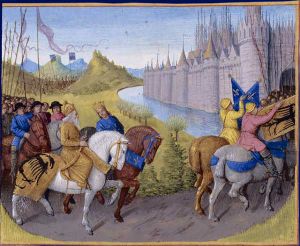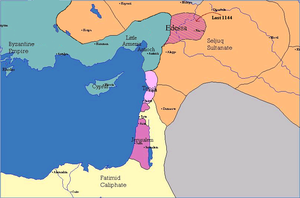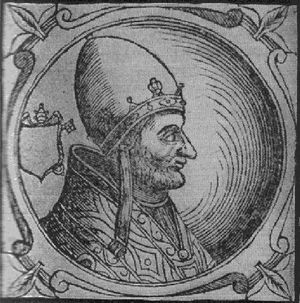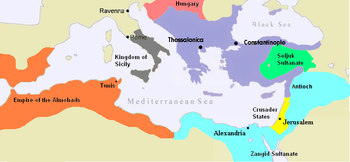مانوِل الأول كومننوس
| مانول الأول كومننوس Manuel I Komnenos | |
|---|---|
| إمبراطور وأوتوقراط الرومان | |
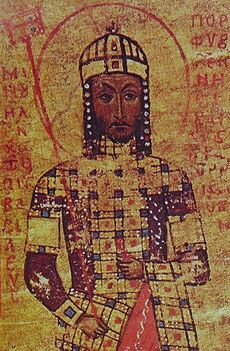 منمنمة مخطوطة لمانول الأول (جزء من پورتريه مزدوج مع ماريا من أنطاكية، مكتبة الڤاتيكان، روما) | |
| إمبراطور بيزنطي | |
| العهد | 5 أبريل 1143 – 24 سبتمبر 1180 |
| سبقه | يوحنا الثاني كومننوس |
| تبعه | ألكسيوس الثاني كومننوس |
| وُلِد | 28 نوفمبر 1118 |
| توفي | 24 سبتمبر 1180 |
| الزوج | Bertha of Sulzbach ماريا من أنطاكية |
| الأنجال | ماريا كومننه ألكسيوس الثاني كومننوس |
| البيت | كومننوي |
| الأب | جون الثاني كومننوس |
| الأم | إرينه من المجر |
| الديانة | المسيحية الأرثوذكسية |
مانول الأول كومننوس (أو كومننوس) (باليونانية: Μανουήλ Κομνηνός، Manouēl I Komnēnos) (28 نوفمبر 1118 – 24 سبتمبر 1180)، كان إمبراطور بيزنطي من القرن 12 حكم في مرحلة فاصلة في التاريخ البيزنطي والمتوسطي.
كحريص على إسترداد امبراطوريته لأمجادها السابقة كقوة عظمى في العالم المتوسطي، تبنى مانويل سياسة خارجية نشطة وطموحة. من خلال التحالفات التي عقدها مع الپاپا والغرب المتنامي، غزا مملكة صقلية، أمن بنجاح ممر للحملة الصليبية الثانية الخطرة من خلال امبراطوريته، وأسس محمية بيزنطية في الدويلات الصليبية وراء البحار. مواجهاً تقدم المسلمين في الأراضي المقدسة، كان له دافع مشترك مع مملكة القدس وللمشاركة في غزوة مشتركة لمصر الفاطمية. أعاد مانول تشكيل الخريطة السياسية للبقان وشرق المتوسط، واضعاً ممالك المجر وما وراء البحار تحت الحكم البيزنطي وقام بحملات صارمة ضد جيرانه في الغرب وفي الشرق. ومع ذلك، ففي هناية حكمه كانت انجازاته مانول في الشرق في خطر بسبب هزيمة خطيرة لاقاها في ميريوكفالون، والتي كانت أدت بشكل كبير إلى غطرسته في الهجوم على السلاجقة. بالرغم من تعافي البيزنطيين وعقد مانول سلام مربح مع السلطان قلج أرسلان الثاني فقد ثبت أن ميريوكفالون كانت الجهد النهائي، والغير مجدي الذي بذله الامبراطور لاسترداد الأناضول من التورك.
يطلق عليه ho Megas (ὁ Μέγας، وتُترجم "العظيم") من قبل اليونانيين، اشتهر مانول بولاءه الملهم تجاه من خدمه. وكذلك يظهر مانول كبطل في التاريخ الذي كتبه مساعده، جون كيناموس، الذي يرجع فيه كل فضيلة إليه. مانول، الذي تأثر باتصاله بالصليبيين الغربيين، تمتع بسمعة أنه "أكثر أباطرة القسطنطينية رحمة" في مناطق العالم اللاتيني كذلك.[1] ومع ذلك، فقد كان المؤرخون المعاصرون أقل حماسة له. بعضهم يؤكد أن القوة العظمى التي كانت في يديه لم تتحقق بإنجازه الشخصي، لكنها كانت للأسرة التي يمثلها؛ ويزعمون أيضاً أن، منذ التراجع الكارثي للسلطة البيزنطية بعد وفاة مانول، كان من الطبيعي أن تم البحث عن أسباب هذا التراجع في عهده.[2]
مانويل الأول إله الحرب مجسماً، وهب نفسه للحرب ومتعتها؛ يسير على الدوام في طليعة جنوده؛ ويرحب بالمبارزة الفردية، وقد انتصر في كل واقعة خاض غمارها إلا الأخيرة من هذه المواقع. وكان في ميدان القتال رواقياً في مبادئه، أما في قصره فكان أبيقورياً، مترفاً في طعامه ولباسه، سعيداً في عشقه الحرام لابنة أخيه. وعادت الآداب والعلوم إلى سابق ازدهارها بفضل ترفه ومناصرته؛ وكانت سيدات البلاط يشجعن المؤلفين، وقد نزلن هن أيضاً من عليائهن ليقرضن الشعر؛ وجمع زناراس في أيامه كتابه الضخم الذي أسماه موجز التاريخ. وشاد مانويل لنفسه قصراً جديداً هو قصر البلاشرني على شاطئ البحر عند طرف القرن الذهبي؛ وكان أودم الدويلي يظنه "أجمل بناء في العالم، فقد كانت عمده وجدرانه مغطاة إلى نصفها بالذهب، ومرصعة بالجواهر التي كانت تتلألأ حتى في ظلام الليل". لقد كانت القسطنطينية في القرن الثاني عشر صورة أخرى من النهضة الإيطالية.[3]
. . . . . . . . . . . . . . . . . . . . . . . . . . . . . . . . . . . . . . . . . . . . . . . . . . . . . . . . . . . . . . . . . . . . . . . . . . . . . . . . . . . . . . . . . . . . . . . . . . . . . . . . . . . . . . . . . . . . . . . . . . . . . . . . . . . . . . . . . . . . . . . . . . . . . . . . . . . . . . . . . . . . . . . .
إرتقاؤه العرش
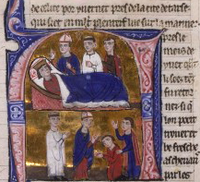
Born on 28 November 1118, Manuel Komnenos was the fourth son of John II Komnenos and Irene of Hungary, so it seemed very unlikely that he would succeed his father.[4] His maternal grandfather was St. Ladislaus. Manuel favourably impressed his father by his courage and fortitude during the unsuccessful Siege of Neocaesarea (1140), against the Danishmendid Turks. In 1143 John II lay dying as a result of an infected wound; on his deathbed he chose Manuel as his successor, in preference to his elder surviving brother Isaac. John cited Manuel's courage and readiness to take advice, in contrast to Isaac's irascibility and unbending pride, as the reasons for his choice. After John died on 8 April 1143,[5] his son, Manuel, was acclaimed emperor by the armies.[6] Yet his succession was by no means assured: with his father's army in the wilds of Cilicia far from Constantinople, he recognised that it was vital he should return to the capital as soon as possible. He still had to take care of his father's funeral, and tradition demanded he organise the foundation of a monastery on the spot where his father died. Swiftly, he dispatched the megas domestikos John Axouch ahead of him, with orders to arrest his most dangerous potential rival, his brother Isaac, who was living in the Great Palace with instant access to the imperial treasure and regalia. Axouch arrived in the capital even before news of the emperor's death had reached it. He quickly secured the loyalty of the city, and when Manuel entered the capital in August 1143, he was crowned by the new patriarch, Michael II Kourkouas. A few days later, with nothing more to fear as his position as emperor was now secure, Manuel ordered the release of Isaac.[7] Then he ordered two golden pieces to be given to every householder in Constantinople and 200 pounds of gold (including 200 silver pieces annually) to be given to the Byzantine Church.[8]
The empire that Manuel inherited from his father was in a more stable position than it had been a century earlier. In the late 11th century, the Byzantine Empire had faced marked military and political decline, but this decline had been arrested and largely reversed by the leadership of Manuel's grandfather and father. Nevertheless, the empire continued to face formidable challenges. At the end of the 11th century, the Normans of Sicily had removed Italy from the control of the Byzantine emperor. The Seljuk Turks had done the same with central Anatolia. And in the Levant, a new force had appeared—the Crusader states—which presented the Byzantine Empire with new challenges. Now, more than at any time during the preceding centuries, the task facing the emperor was daunting indeed.[9]
الحملة الصليبية الثانية ورينالد من شاتيون
أمير أنطاكية
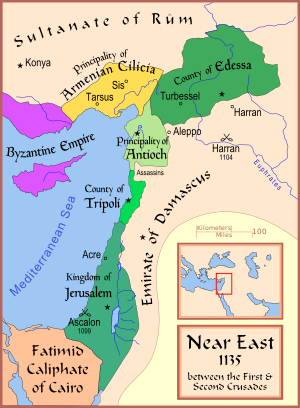
The first test of Manuel's reign came in 1144, when he was faced with a demand by Raymond, Prince of Antioch for the cession of Cilician territories. However, later that year the crusader County of Edessa was engulfed by the tide of a resurgent Islamic jihad under Imad ad-Din Zengi. Raymond realized that immediate help from the west was out of the question. With his eastern flank now dangerously exposed to this new threat, there seemed little option but for him to prepare for a humiliating visit to Constantinople. Swallowing his pride, he made the journey north to submit to Manuel and ask for protection. He was promised the support that he had requested, and his allegiance to Byzantium was secured.[10]
التجريدة على قونية
In 1146 Manuel assembled his army at the military base Lopadion and set out on a punitive expedition against Mas'ud, the Sultan of Rûm, who had been repeatedly violating the frontiers of the Empire in western Anatolia and Cilicia.[11] There was no attempt at a systematic conquest of territory, but Manuel's army defeated the Turks at Acroënus, before capturing and destroying the fortified town of Philomelion, removing its remaining Christian population.[11] The Byzantine forces reached Masud's capital, Konya, and ravaged the area around the city, but could not assault its walls. Among Manuel's motives for mounting this razzia there included a wish to be seen in the West as actively espousing the crusading ideal; Kinnamos also attributed to Manuel a desire to show off his martial prowess to his new bride.[12] While on this campaign Manuel received a letter from Louis VII of France announcing his intention of leading an army to the relief of the crusader states.[13]
وصول الصليبيين
Manuel was prevented from capitalising on his conquests by events in the Balkans that urgently required his presence. In 1147 he granted a passage through his dominions to two armies of the Second Crusade under Conrad III of Germany and Louis VII of France. At this time, there were still members of the Byzantine court who remembered the passage of the First Crusade, a defining event in the collective memory of the age that had fascinated Manuel's aunt, Anna Komnene.[14]
Many Byzantines feared the Crusade, a view endorsed by the numerous acts of vandalism and theft practised by the unruly armies as they marched through Byzantine territory. Byzantine troops followed the Crusaders, attempting to police their behaviour, and further troops were assembled in Constantinople, ready to defend the capital against any acts of aggression. This cautious approach was well advised, but still the numerous incidents of covert and open hostility between the Franks and the Greeks on their line of march, for which it seems both sides were to blame, precipitated conflict between Manuel and his guests. Manuel took the precaution—which his grandfather had not taken—of making repairs to the city walls, and he pressed the two kings for guarantees concerning the security of his territories. Conrad's army was the first to enter the Byzantine territory in the summer of 1147, and it figures more prominently in the Byzantine sources, which imply that it was the more troublesome of the two.a[›] Indeed, the contemporary Byzantine historian Kinnamos describes a full-scale clash between a Byzantine force and part of Conrad's army, outside the walls of Constantinople. The Byzantines defeated the Germans and, in Byzantine eyes, this reverse caused Conrad to agree to have his army speedily ferried across to Damalis on the Asian shore of the Bosphoros.[15][16]
After 1147, however, the relations between the two leaders became friendlier. By 1148 Manuel had seen the wisdom of securing an alliance with Conrad, whose sister-in-law Bertha of Sulzbach he had earlier married; he actually persuaded the German king to renew their alliance against Roger II of Sicily.[17] Unfortunately for the Byzantine emperor, Conrad died in 1152, and despite repeated attempts, Manuel could not reach an agreement with his successor, Frederick Barbarossa.b[›]
غزو قبرص
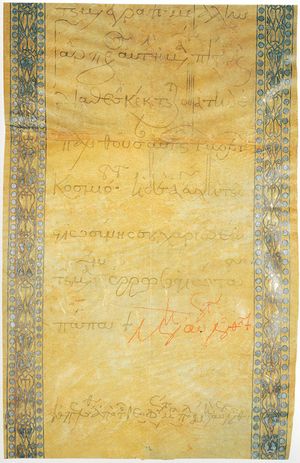
Manuel's attention was again drawn to Antioch in 1156, when Raynald of Châtillon, the new Prince of Antioch, claimed that the Byzantine emperor had reneged on his promise to pay him a sum of money and vowed to attack the Byzantine province of Cyprus.[19] Raynald arrested the governor of the island, John Komnenos, who was a nephew of Manuel, and the general Michael Branas.[20] The Latin historian William of Tyre deplored this act of war against fellow Christians and described the atrocities committed by Raynald's men in considerable detail.[21] Having ransacked the island and plundered all its wealth, Raynald's army mutilated the survivors before forcing them to buy back their flocks at exorbitant prices with what little they had left. Thus enriched with enough booty to make Antioch wealthy for years, the invaders boarded their ships and set sail for home.[22] Raynald also sent some of the mutilated hostages to Constantinople as a vivid demonstration of his disobedience and his contempt for the Byzantine emperor.[20]
Manuel responded to this outrage in a characteristically energetic way. In the winter of 1158–59, he marched to Cilicia at the head of a huge army; the speed of his advance (Manuel had hurried on ahead of the main army with 500 cavalry) was such that he managed to surprise the Armenian Thoros of Cilicia, who had participated in the attack on Cyprus.[23] Thoros fled into the mountains, and Cilicia swiftly fell to Manuel.[24]
مانوِل في أنطاكية
Meanwhile, news of the advance of the Byzantine army soon reached Antioch. Raynald knew that he had no hope of defeating the emperor, and in addition knew that he could not expect any aid from King Baldwin III of Jerusalem. Baldwin did not approve of Raynald's attack on Cyprus, and in any case had already made an agreement with Manuel. Thus isolated and abandoned by his allies, Raynald decided that abject submission was his only hope. He appeared dressed in a sack with a rope tied around his neck, and begged for forgiveness. Manuel at first ignored the prostrate Raynald, chatting with his courtiers; William of Tyre commented that this ignominious scene continued for so long that all present were "disgusted" by it.[25] Eventually, Manuel forgave Raynald on condition that he would become a vassal of the Empire, effectively surrendering the independence of Antioch to Byzantium.[4]
Peace having been restored, a grand ceremonial procession was staged on 12 April 1159 for the triumphant entry of the Byzantine army into the city, with Manuel riding through the streets on horseback, while the Prince of Antioch and the King of Jerusalem followed on foot. Manuel dispensed justice to the citizens and presided over games and tournaments for the crowd. In May, at the head of a united Christian army, he started on the road to Edessa, but he abandoned the campaign when he secured the release by Nur ad-Din, the ruler of Syria, of 6,000 Christian prisoners captured in various battles since the second Crusade.[26] Despite the glorious end of the expedition, modern scholars argue that Manuel ultimately achieved much less than he had desired in terms of imperial restoration.c[›]
Satisfied with his efforts thus far, Manuel headed back to Constantinople. On their way back, his troops were surprised in line of march by the Turks. Despite this, they won a complete victory, routing the enemy army from the field and inflicting heavy losses. In the following year, Manuel drove the Turks out of Isauria.[27]
. . . . . . . . . . . . . . . . . . . . . . . . . . . . . . . . . . . . . . . . . . . . . . . . . . . . . . . . . . . . . . . . . . . . . . . . . . . . . . . . . . . . . . . . . . . . . . . . . . . . . . . . . . . . . . . . . . . . . . . . . . . . . . . . . . . . . . . . . . . . . . . . . . . . . . . . . . . . . . . . . . . . . . . .
الحملات الإيطالية
روجر الثاني من صقلية
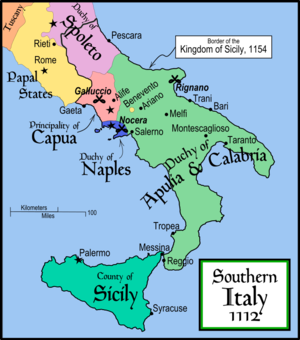
In 1147 Manuel was faced with war by Roger II of Sicily, whose fleet had captured the Byzantine island of Corfu and plundered Thebes and Corinth. However, despite being distracted by a Cuman attack in the Balkans, in 1148 Manuel enlisted the alliance of Conrad III of Germany, and the help of the Venetians, who quickly defeated Roger with their powerful fleet. In 1149, Manuel recovered Corfu and prepared to take the offensive against the Normans, while Roger II sent George of Antioch with a fleet of 40 ships to pillage Constantinople's suburbs.[28] Manuel had already agreed with Conrad on a joint invasion and partition of southern Italy and Sicily. The renewal of the German alliance remained the principal orientation of Manuel's foreign policy for the rest of his reign, despite the gradual divergence of interests between the two empires after Conrad's death.[17]
Roger died in February 1154 and was succeeded by William I, who faced widespread rebellions against his rule in Sicily and Apulia, leading to the presence of Apulian refugees at the Byzantine court. Conrad's successor, Frederick Barbarossa, launched a campaign against the Normans, but his expedition stalled. These developments encouraged Manuel to take advantage of the multiple instabilities on the Italian peninsula.[29] He sent Michael Palaiologos and John Doukas, both of whom held the high imperial rank of sebastos, with Byzantine troops, ten ships and large quantities of gold to invade Apulia in 1155.[30] The two generals were instructed to enlist the support of Frederick, but he declined because his demoralised army longed to get back north of the Alps as soon as possible.b[›] Nevertheless, with the help of disaffected local barons, including Count Robert of Loritello, Manuel's expedition achieved astonishingly rapid progress as the whole of southern Italy rose up in rebellion against the Sicilian Crown and the untried William I.[17] There followed a string of spectacular successes as numerous strongholds yielded either to force or the lure of gold.[26]
الحلف الپاپوي-البيزنطي
The city of Bari, which had been the capital of the Byzantine Catapanate of Italy for centuries before the arrival of the Normans, opened its gates to the Emperor's army, and the overjoyed citizens tore down the Norman citadel. After the fall of Bari, the cities of Trani, Giovinazzo, Andria, Taranto and Brindisi were also captured. William arrived with his army, including 2,000 knights, but was heavily defeated.[31]
Encouraged by the success, Manuel dreamed of restoration of the Roman Empire, at the cost of union between the Orthodox and the Catholic Church, a prospect which would frequently be offered to the Pope during negotiations and plans for alliance.[32] If there was ever a chance of reuniting the eastern and western churches, and coming to reconciliation with the Pope permanently, this was probably the most favourable moment. The Papacy was never on good terms with the Normans, except when under duress by the threat of direct military action. Having the "civilised" Byzantines on its southern border was infinitely preferable to the Papacy than having to constantly deal with the troublesome Normans of Sicily. It was in the interest of Pope Adrian IV to reach a deal if at all possible, since doing so would greatly increase his own influence over the entire Orthodox Christian population. Manuel offered a large sum of money to the Pope for the provision of troops, with the request that the Pope grant the Byzantine emperor lordship of three maritime cities in return for assistance in expelling William from Sicily. Manuel also promised to pay 5,000 pounds of gold to the Pope and the Curia.[33] Negotiations were hurriedly carried out, and an alliance was formed between Manuel and Hadrian.[29]
| "Alexios Komnenos and Doukas ... had become captive to the Sicilians' lord [and] again ruined matters. For as they had already pledged to the Sicilians many things not then desired by the emperor, they robbed the Romans of very great and noble achievements. [They] ... very likely deprived the Roman of the cities too soon." |
| John Cinnamus[34] |
At this point, just as the war seemed decided in his favour, events turned against Manuel. Byzantine commander Michael Palaiologos alienated allies with his attitude, stalling the campaign as Count Robert III of Loritello refused to speak to him. Although the two were reconciled, the campaign had lost some of its momentum: Michael was soon recalled to Constantinople, and his loss was a major blow to the campaign. The turning point was the Battle of Brindisi, where the Normans launched a major counter-attack by both land and sea. At the approach of the enemy, the mercenaries that had been hired with Manuel's gold demanded huge increases in their pay. When this was refused, they deserted. Even the local barons started to melt away, and soon John Doukas was left hopelessly outnumbered. The arrival of Alexios Komnenos Bryennios with some ships failed to retrieve the Byzantine position.d[›] The naval battle was decided in favour of the Normans, while John Doukas and Alexios Bryennios (along with four Byzantine ships) were captured.[35] Manuel then sent Alexios Axouch to Ancona to raise another army, but by this time William had already retaken all of the Byzantine conquests in Apulia. The defeat at Brindisi put an end to the restored Byzantine reign in Italy; in 1158 the Byzantine army left Italy and never returned again.[36] Both Nicetas Choniates and Kinnamos, the major Byzantine historians of this period, agree, however, that the peace terms Axouch secured from William allowed Manuel to extricate himself from the war with dignity, despite a devastating raid by a Norman fleet of 164 ships (carrying 10,000 men) on Euboea and Almira in 1156.[37]
فشل وحدة الكنيسة
During the Italian campaign, and afterwards, during the struggle of the Papal Curia with Frederick, Manuel tried to sway the popes with hints of a possible union between the Eastern and Western churches. Although in 1155 Pope Adrian IV had expressed his eagerness to prompt the reunion of the churches,e[›] hopes for a lasting Papal-Byzantine alliance came up against insuperable problems. Adrian IV and his successors demanded recognition of their religious authority over all Christians everywhere and sought superiority over the Byzantine emperor; they were not at all willing to fall into a state of dependence from one emperor to the other.[32] Manuel, on the other hand, wanted an official recognition of his secular authority over both East and West.[38] Such conditions would not be accepted by either side. Even if a pro-western emperor such as Manuel agreed, the Greek citizens of the empire would have rejected outright any union of this sort, as they did almost three hundred years later when the Orthodox and Catholic churches were briefly united under the pope. In spite of his friendliness towards the Roman Church and his cordial relations with all the popes, Manuel was never honoured with the title of augustus by the popes. And although he twice sent embassies to Pope Alexander III (in 1167 and 1169) offering to reunite the Greek and Latin churches, Alexander refused, under pretext of the troubles that would follow union.[39]
The final results of the Italian campaign were limited in terms of the advantages gained by the Empire. The city of Ancona became a Byzantine base in Italy, accepting Manuel as sovereign. The Normans of Sicily had been damaged and now came to terms with the Empire, ensuring peace for the rest of Manuel's reign. The Empire's ability to get involved in Italian affairs had been demonstrated. However, given the enormous quantities of gold which had been lavished on the project, it also demonstrated the limits of what money and diplomacy alone could achieve. The expense of Manuel's involvement in Italy must have cost the treasury a great deal (probably more than 2.16 million hyperpyra or 30,000 pounds of gold), and yet it produced only limited solid gains.[40][41]
السياسة البيزنطية في إيطالية بعد 1158
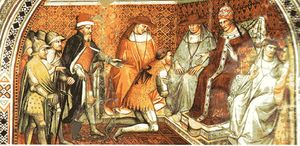
After 1158, under the new conditions, the aims of the Byzantine policy changed. Manuel now decided to oppose the objective of the Hohenstaufen dynasty to directly annex Italy, which Frederick believed should acknowledge his power. When the war between Frederick Barbarossa and the northern Italian communes started, Manuel actively supported the Lombard League with money subsidies, agents, and, occasionally, troops.[42] The walls of Milan, demolished by the Germans, were restored with Manuel's aid.[43] Ancona remained important as a centre of Byzantine influence in Italy. The Anconitans made a voluntary submission to Manuel, and the Byzantines maintained representatives in the city.[44] Frederick's defeat at the Battle of Legnano, on 29 May 1176, seemed rather to improve Manuel's position in Italy. According to Kinnamos, Cremona, Pavia and a number of other "Ligurian" cities went over to Manuel;[45] his relations were also particularly favourable in regard to Genoa and Pisa, but not to Venice. In March 1171 Manuel had suddenly broken with Venice, ordering all 20,000 Venetians on imperial territory to be arrested and their property confiscated.[46] Venice, incensed, sent a fleet of 120 ships against Byzantium. Due to an epidemic, and pursued by 150 Byzantine ships, the fleet was forced to return without great success.[47] In all probability, friendly relations between Byzantium and Venice were not restored in Manuel's lifetime.[32]
. . . . . . . . . . . . . . . . . . . . . . . . . . . . . . . . . . . . . . . . . . . . . . . . . . . . . . . . . . . . . . . . . . . . . . . . . . . . . . . . . . . . . . . . . . . . . . . . . . . . . . . . . . . . . . . . . . . . . . . . . . . . . . . . . . . . . . . . . . . . . . . . . . . . . . . . . . . . . . . . . . . . . . . .
تخوم البلقان
On his northern frontier Manuel expended considerable effort to preserve the conquests made by Basil II over one hundred years earlier and maintained, sometimes tenuously, ever since. Due to distraction from his neighbours on the Balkan frontier, Manuel was kept from his main objective, the subjugation of the Normans of Sicily. Relations had been good with the Serbs and Hungarians since 1129, so the Serb rebellion came as a shock. The Serbs of Rascia, being so induced by Roger II of Sicily, invaded Byzantine territory in 1149.[4]
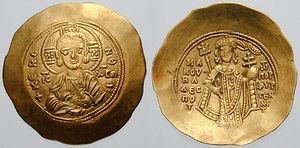
Manuel forced the rebellious Serbs, and their leader, Uroš II, to vassalage (1150–1152).[48] He then made repeated attacks upon the Hungarians with a view to annexing their territory along the Sava. In the wars of 1151–1153 and 1163–1168 Manuel led his troops into Hungary and a spectacular raid deep into enemy territory yielded substantial war booty. In 1167, Manuel sent 15,000 men under the command of Andronikos Kontostephanos against the Hungarians,[49] scoring a decisive victory at the Battle of Sirmium and enabling the Empire to conclude a very advantageous peace with the Kingdom of Hungary by which Syrmia, Bosnia and Dalmatia were ceded. By 1168 nearly the whole of the eastern Adriatic coast lay in Manuel's hands.[50]
Efforts were also made towards a diplomatic annexation of Hungary. The Hungarian heir Béla, younger brother of the Hungarian king Stephen III, was sent to Constantinople to be educated in the emperor's court. Manuel intended the youth to marry his daughter, Maria, and to make him his heir, thus securing the union of Hungary with the Empire. At court Béla assumed the name Alexius and received the title of despot, which had previously been applied only to the emperor himself. However, two unforeseen dynastic events drastically altered the situation. In 1169, Manuel's young wife gave birth to a son, thus depriving Béla of his status as heir of the Byzantine throne (although Manuel would not renounce the Croatian lands he had taken from Hungary). Then, in 1172, Stephen died childless, and Béla went home to take his throne. Before leaving Constantinople, he swore a solemn oath to Manuel that he would always "keep in mind the interests of the emperor and of the Romans". Béla III kept his word: as long as Manuel lived, he made no attempt to retrieve his Croatian inheritance, which he only afterwards reincorporated into Hungary.[50]
العلاقات مع روس الكييڤية (روسيا)
Manuel Komnenos attempted to draw the Russian principalities into his net of diplomacy directed against Hungary, and to a lesser extent Norman Sicily. This polarised the Russian princes into pro- and anti-Byzantine camps. In the late 1140s three princes were competing for primacy in Russia: prince Iziaslav II of Kiev was related to Géza II of Hungary and was hostile to Byzantium; Prince Yuri Dolgoruki of Suzdal was Manuel's ally (symmachos), and Vladimirko of Galicia (Principality of Halych) is described as Manuel's vassal (hypospondos). Galicia was situated on the northern and north-eastern borders of Hungary and, therefore, was of great strategic importance in the Byzantine-Hungarian conflicts. Following the deaths of both Iziaslav and Vladimirko, the situation became reversed; when Yuri of Suzdal, Manuel's ally, took over Kiev and Yaroslav, the new ruler of Galicia, adopted a pro-Hungarian stance.[51]
In 1164–65 Manuel's cousin Andronikos, the future emperor, escaped from captivity in Byzantium and fled to the court of Yaroslav in Galicia. This situation, holding out the alarming prospect of Andronikos making a bid for Manuel's throne sponsored by both Galicia and Hungary, spurred the Byzantines into an unprecedented flurry of diplomacy. Manuel pardoned Andronikos and persuaded him to return to Constantinople in 1165. A mission to Kiev, then ruled by Prince Rostislav, resulted in a favourable treaty and a pledge to supply the Empire with auxiliary troops; Yaroslav of Galicia was also persuaded to renounce his Hungarian connections and return fully into the imperial fold. As late as 1200 the princes of Galicia were providing invaluable services against the enemies of the Empire, at that time the Cumans.[52]
The restoration of relations with Galicia had an immediate benefit for Manuel when, in 1166, he dispatched two armies to attack the eastern provinces of Hungary in a vast pincer movement. One army crossed the Walachian Plain and entered Hungary through the Transylvanian Alps (Southern Carpathians), while the other army made a wide circuit to Galicia and, with Galician aid, crossed the Carpathian Mountains. Since the Hungarians had most of their forces concentrated on the Sirmium and Belgrade frontier, they were caught off guard by the Byzantine invasion; this resulted in the Hungarian province of Transylvania being thoroughly ravaged by the Byzantine armies.[53]
غزو مصر
التحالف مع مملكة بيت المقدس
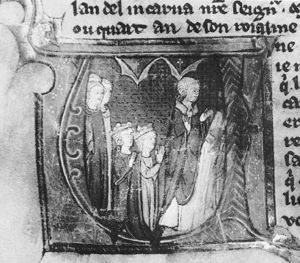
السيطرة على مصر كانت حلماً راود مملكة القدس الصليبية لعقود، وكان الملك أمالريك الأول من القدس بحاجة لكامل الدعم العسكري والمالي لتعزيز سياسته العسكرية ليتمكن من التدخل في مصر.[54] أدرك أمالريك أيضاً أنه لمواصلة طموحاته في مصر، فيجب عليه أن يترك أنطاكية لسيطرة مانوِل الذي دفع 100.000 دينار لإطلاق سراح بوهيمند الثالث.[55][56] عام 1165، أرسل مبعوثون للبلاط البيزنطي لمناقشة زواج تحالف (مانول كان قد تزوج بالفعل من ابنة عم أمالريك ماريا من أنطاكية في 1161).[57] بعد أطول من سنتين، تزوج أمالريك من الابنة الكبرى لشقيقة مانوِل ماريا كومننه عام 1167، "وأقسم على جميع ما أقسم عليه شقيقه بالدوين من قبل".f[›] عام 1168 كان هناك تفاوض على تحالف رسمي، حيث رتب فيه الحاكمان غزو وتقسيم مصر، ليأخذ مانوِل المنطقة الساحلية، وأمالريك الأراضي الداخلية. في خريف 1169، أرسل مانوِل تجريدة مشتركة مع أمالريك إلى مصر: الجيش البيزنطي وقوة بحرية تضم 20 سفينة حربية ضخمة، 150 قادس، و60 وسيلة نقل، تحت قيادة megas doux أندرونيكوس كونتوستفانوس ووصلت القوات المشتركة مع أمالريك إلى عسقلان.[57][58] وليام من صور، الذي تفاوض مع التحالف، كان متأثراً ولاسيما بسفن النقل الضخمة التي كانت تستخدم لنقل قوات الفرسان.[59]
بالرغم من أن مثل هذا الهجوم بعيد المدى على ولاية بعيدة عن مركز الامبراطورية قد يبدو على أنه إستثنائي (آخر مرة حاولت فيها الامبراطورية تحرك من هذا النوع كان غزو فاشل لصقلية قبل 122 سنة)، إلا أنه يمكن تفسيره في ظل سياسة مانوِل الخارجية، والذي كان يستخدم اللاتين لتأمين حياة الامبراطورية. التركيز على الصورة الأكبر لشرق المتوسط وعلى حتى أبعد من ذلك مما دفع بمانوِل للغزو مصر: كان يعتقد أنه في سياق النضال الأوسع بين الدويلات الصليبية والقوى الإسلامية في الشرق، أن السيطرة على مصر ستكون عامل الحسم. أصبح من الواضح أن الخلافة الفاطمية الضعيفة في مصر كانت تحمل مفاتيح الدويلات الصليبية. إذا ما خرجت مصر من عزلتها، والقوى المتشكرة مع المسلمين بقيادة نور الدين، فسيصبح الصليبيون في مأزق.[54]
سيحقق الغزو الناجح لمصر الكثير من المزايا للامبراطورية البيزنطية. كانت مصر مقاطعة غنية، وفي عهد الامبراطورية الرومانية كانت تمد القسطنطينية بالكثير من المحاصير قبل أن يستولي عليها العرب في القرن السابع. الأرباح التي تتوقعها الامبراطورية جراء غزو مصر كانت جديرة بالاهتمام، حتى لو كانت ستتقاسمها مع الصليبيين. بالإضافة إلى ذلك، فمن المحتمل أن مانوِل أراد أن يشجع خطط أمالريك، ليس فقط ليصرف طموحات اللاتين عن أنطاكية، لكن أيضاً لتأسيس لخلق فرص عسكرية جديدة من شأنها أن تحافظ على مملكة القدس في يده، وأيضاً ليسمح أن تتشارك الامبراطورية في المكاسب الاقليمية.[54]
فشل التجريدة
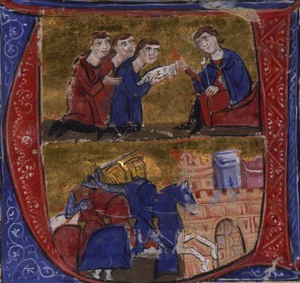
ضربت القوات المشتركة لمانوِل وأمالريك حصاراً على دمياط في 27 أكتوبر 1169، لكن الحصار كان غير ناجحاً لفشل الصليبيون والبيزنظيون في التعاون الكامل.[60] حسب القوات البيزنطية، أمالريك، لم يكن لديه الرغبة في تقاسم مكاسب النصر، dragged out the operation until the emperor's men ran short of provisions وتأثرات بشكل كبير بالمجاعة؛ ثم قام أمالريك بالهجوم، والذي أهجض على الفور بعد عقد مفاوضات مع القوات المدافعة. على الجانب الآخر، وحسب وليام من صور فلم يكن اللوم على اليونانيين بالكامل.[61] مهما كانت حقيقة هذه الادعاءات من كلا الجانبين، فعندما هطلت الأمطار، عاد الجيش اللاتيني والأسطول البيزنطي للوطن، بالرغم من أن نصف الأسطول البيزنطي كان قد فقط في عاصفة مفاجئة.[62]
بالرغم من المشاعر السيئة التي تولدت تجاه دمياط، إلا أن أمالريك لا يزال يرفض التخلي عن حلمه بغزو مصر، واستمر في السعي لعلاقات طيبة مع البيزنطيين أملاً في هجوم مشترك آخر، والذي لم يحدث أبداً.[63] عام أتى أمالريك بنفسه إلى القسنطينية، بعدما سقطت مصر في يد صلاح الدين. عام 1171 أصبح مانوِل قادراً على تنظيم استقبال اتحفالي كبير لتكريم أمالريك، ولتأكيد ولاؤه: لبقية عهد أمالريك، كانت القدس تابعة للبيزنطيين، وكان مانوِل قادراً على القيام بدور الحامي للأماكن المقدسة، وممارسة نفوذ متزايد في مملكة القدس.[64] عام 1177، أرسل مانوِل الأول أسطول من 150 سفينة لغزو مصر، لكنه قفل راجعاً بعد وصوله قبالة سواحل عكا لرفض الكونت فليپ الأول وكثير من النبلاء البارزين في مملكة القدس المساعدة.[55]
قلج أرسلان الثاني والأتراك السلاجقة
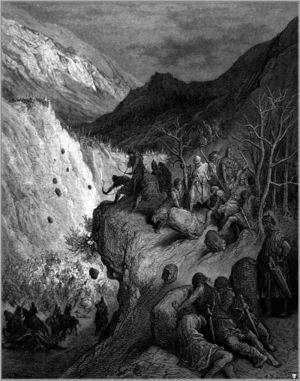
فيما بين 1158-1162، قامت سلسلة من الحملات البيزنطية على التورك السلاجقة في سلطنة الروم أسفرت عن إبرام معاهدة لصالح الامبراطورية البيزنطية. حسب الاتفاقية بعض المناطق الحدودية، تشمل مدينة سيڤاس، ينبغي أن تسلم لمانوِل مقابل مبلغ من المال.[65] ومع ذلك، فعندما أصبح من الجلي أن السلاجقة ليس لديهم النية لاحترام هذه المعاهدة، قرر مانوِل أنه حان الوقت للتعاون مع الأتراك مرة واحدة وإلى الأبد.[66] ومن ثم، حشد مانوِل جيش إمبراطوري كامل، واتجاه للعاصمة السلجوقية دوريلايوم وسوبلايوم، ليستخدمهم كمركز للهجوم بأقصى سرعة ممكنة على إيكونيوم.[67]
Yet Manuel's army of 35,000 men was large and unwieldy—according to a letter that Manuel sent to King Henry II of England, the advancing column was ten miles (16 km) long.[68] Manuel marched against Iconium via Laodicea, Chonae, Lampe, Celaenae, Choma and Antioch. Just outside the entrance to the pass at Myriokephalon, Manuel was met by Turkish ambassadors, who offered peace on generous terms. Most of Manuel's generals and experienced courtiers urged him to accept the offer. The younger and more aggressive members of the court urged Manuel to attack, however, and he took their advice and continued his advance.[26]
Manuel made serious tactical errors, such as failing to properly scout out the route ahead.[69] These failings caused him to lead his forces straight into a classic ambush. On 17 September 1176 Manuel was checked by Seljuk Sultan Kilij Arslan II at the Battle of Myriokephalon (in highlands near the Tzibritze pass), in which his army was ambushed while marching through the narrow mountain pass.[42][70] The Byzantines were hemmed in by the narrowness of the pass, this allowed the Seljuks to concentrate their attacks on part of the Byzantine army, especially the baggage and siege train, without the rest being able to intervene.[71] The army's siege equipment was quickly destroyed, and Manuel was forced to withdraw—without siege engines, the conquest of Iconium was impossible. According to Byzantine sources, Manuel lost his nerve both during and after the battle, fluctuating between extremes of self-delusion and self-abasement;[72] according to William of Tyre, he was never the same again.[73]
The terms by which Kilij Arslan II allowed Manuel and his army to leave were that he should remove his forts and armies on the frontier at Dorylaeum and Sublaeum. Since the Sultan had already failed to keep his side of the earlier treaty of 1162, however, Manuel only ordered the fortifications of Sublaeum to be dismantled, but not the fortifications of Dorylaeum.[74] Nevertheless, defeat at Myriokephalon was an embarrassment for both Manuel personally and also for his empire. The Komnenian emperors had worked hard since the Battle of Manzikert, 105 years earlier, to restore the reputation of the empire. Yet because of his over-confidence, Manuel had demonstrated to the whole world that Byzantium still could not decisively defeat the Seljuks, despite the advances made during the past century. In western opinion, Myriokephalon cut Manuel down to a humbler size: not that of Emperor of the Romans but that of King of the Greeks.[70]
The defeat at Myriokephalon has often been depicted as a catastrophe in which the entire Byzantine army was destroyed. Manuel himself compared the defeat to Manzikert; it seemed to him that the Byzantine defeat at Myriokephalon complemented the destruction at Manzikert. In reality, although a defeat, it was not too costly and did not significantly diminish the Byzantine army.[70] Most of the casualties were borne by the right wing, largely composed of allied troops commanded by Baldwin of Antioch, and also by the baggage train, which was the main target of the Turkish ambush.[75]
The limited losses inflicted on native Byzantine troops were quickly recovered, and in the following year Manuel's forces defeated a force of "picked Turks".[67] John Komnenos Vatatzes, who was sent by the Emperor to repel the Turkish invasion, not only brought troops from the capital but also was able to gather an army along the way. Vatatzes caught the Turks in an ambush as they were crossing the Meander River; the subsequent Battle of Hyelion and Leimocheir effectively destroyed them as a fighting force. This is an indication that the Byzantine army remained strong and that the defensive program of western Asia Minor was still successful.[76] After the victory on the Meander, Manuel himself advanced with a small army to drive the Turks from Panasium, south of Cotyaeum.[74]
In 1178, however, a Byzantine army retreated after encountering a Turkish force at Charax, allowing the Turks to capture many livestock.[4] The city of Claudiopolis in Bithynia was besieged by the Turks in 1179, forcing Manuel to lead a small cavalry force to save the city, and then, even as late as 1180, the Byzantines succeeded in scoring a victory over the Turks.[4]
The continuous warfare had a serious effect upon Manuel's vitality; he declined in health and in 1180 succumbed to a slow fever. Furthermore, like Manzikert, the balance between the two powers began to gradually shift—Manuel never again attacked the Turks, and after his death they began to move further west, deeper into Byzantine territory.[77]
الجدالات العقائدية (1156–1180)
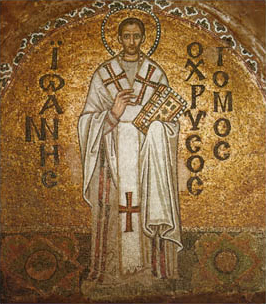
Three major theological controversies occurred during Manuel's reign. In 1156–1157 the question was raised whether Christ had offered Himself as a sacrifice for the sins of the world to the Father and to the Holy Spirit only, or also to the Logos (i.e., to Himself).[78] In the end a synod held at Constantinople in 1157 declared the doctrine of a single sacrifice to the Holy Trinity, producing a formula: "The precious blood of the Only Begotten was offered not only to the Father but also to the Son and the Holy Ghost, the one Godhead", despite the dissent of Patriarch of Antioch-elect Soterichos Panteugenos, who was subsequently dismissed.[79][80][4]
Ten years later, a controversy arose as to whether the saying of Christ, "My Father is greater than I", referred to his divine nature, to his human nature, or to the union of the two.[78] Demetrius of Lampe, a Byzantine diplomat recently returned from the West, ridiculed the way the verse was interpreted there, that Christ was inferior to his father in his humanity but equal in his divinity. Manuel, on the other hand, perhaps with an eye on the project for Church union, found that the formula made sense, and prevailed over a majority in a synod convened on 2 March 1166 to decide the issue, where he had the support of the patriarch Luke Chrysoberges[4] and later Patriarch Michael III.[81] Those who refused to submit to the synod's decisions had their property confiscated or were exiled.g[›] The political dimensions of this controversy are apparent from the fact that a leading dissenter from the Emperor's doctrine was his nephew Alexios Kontostephanos.[82]
A third controversy sprung up in 1180, when Manuel objected to the formula of solemn abjuration, which was exacted from Muslim converts. One of the more striking anathemas of this abjuration was that directed against the deity worshipped by Muhammad and his followers:[83]
And before all, I anathematize the God of Muhammad about whom he [Muhammad] says, "He is God alone, God made of solid, hammer-beaten metal; He begets not and is not begotten, nor is there like unto Him any one."
The emperor ordered the deletion of this anathema from the Church's catechetical texts, a measure that provoked vehement opposition from both the Patriarch and bishops.[83]
روايات الفرسان

Manuel is representative of a new kind of Byzantine ruler who was influenced by his contact with western Crusaders. He arranged jousting matches, even participating in them, an unusual and discomforting sight for the Byzantines. Endowed with a fine physique, Manuel has been the subject of exaggeration in the Byzantine sources of his era, where he is presented as a man of great personal courage. According to the story of his exploits, which appear as a model or a copy of the romances of chivalry, such was his strength and exercise in arms that Raymond of Antioch was incapable of wielding his lance and buckler. In a famous tournament, he is said to have entered the lists on a fiery courser, and to have overturned two of the stoutest Italian knights. In one day, he is said to have slain forty Turks with his own hand, and in a battle against the Hungarians he allegedly snatched a banner, and was the first, almost alone, who passed a bridge that separated his army from the enemy. On another occasion, he is said to have cut his way through a squadron of five hundred Turks, without receiving a wound; he had previously posted an ambuscade in a wood and was accompanied only by his brother and Axouch.[84]
الأسرة
Manuel had two wives. His first marriage, in 1146, was to Bertha of Sulzbach, a sister-in-law of Conrad III of Germany. She died in 1159. Children:
- Maria Komnene (1152[85]–1182), wife of Renier of Montferrat.
- Anna Komnene[85] (1154–1158).
Manuel's second marriage was to Maria of Antioch (nicknamed Xene), a daughter of Raymond and Constance of Antioch, in 1161. By this marriage, Manuel had one son:
- Alexios II Komnenos, who succeeded as emperor in 1180.[86]
Manuel had several illegitimate children:
By Theodora Vatatzina:
- Alexios Komnenos (born in the early 1160s), who was recognised as the emperor's son, and indeed received a title (sebastokrator). He was briefly married to Eirene Komnene, illegitimate daughter of Andronikos I Komnenos, in 1183–1184, and was then blinded by his father-in-law. He lived until at least 1191 and was known personally to Choniates.[87]
By Maria Taronitissa, the wife of John Doukas Komnenos:
- Alexios Komnenos, a pinkernes ("cupbearer"), who fled Constantinople in 1184 and was a figurehead of the Norman invasion and the siege of Thessalonica in 1185.
By other lovers:
- A daughter whose name is unknown. She was born around 1150 and married Theodore Maurozomes before 1170. Her son was Manuel Maurozomes, whose daughter married Kaykhusraw I, the Seljuk Sultanate of Rûm, and her descendants ruled the sultanate from 1220 to 1246.[88]
- A daughter whose name is unknown, born around 1155. She was the maternal grandmother of the author Demetrios Tornikes.[89]
تقييم
الشؤون الخارجية والعسكرية
As a young man, Manuel had been determined to restore by force of arms the predominance of the Byzantine Empire in the Mediterranean countries. By the time he died in 1180, 37 years had passed since that momentous day in 1143 when, amid the wilds of Cilicia, his father had proclaimed him emperor. These years had seen Manuel involved in conflict with his neighbours on all sides. Manuel's father and grandfather before him had worked patiently to undo the damage done by the battle of Manzikert and its aftermath. Thanks to their efforts, the empire Manuel inherited was stronger and better organised than at any time for a century. While it is clear that Manuel used these assets to the full, it is not so clear how much he added to them, and there is room for doubt as to whether he used them to best effect.[1]
| "The most singular feature in the character of Manuel is the contrast and vicissitude of labour and sloth, of hardiness and effeminacy. In war he seemed ignorant of peace, in peace he appeared incapable of war." |
| Edward Gibbon[90] |
Manuel had proven himself to be an energetic emperor who saw possibilities everywhere, and whose optimistic outlook had shaped his approach to foreign policy. However, in spite of his military prowess Manuel achieved but a slight degree of his object of restoring the Byzantine Empire. Retrospectively, some commentators have criticised some of Manuel's aims as unrealistic, in particular citing the expeditions he sent to Egypt as proof of dreams of grandeur on an unattainable scale. His greatest military campaign, his grand expedition against the Turkish Sultanate of Iconium, ended in humiliating defeat, and his greatest diplomatic effort apparently collapsed, when Pope Alexander III became reconciled to the German emperor Frederick Barbarossa at the Peace of Venice. Historian Mark C. Bartusis argues that Manuel (and his father as well) tried to rebuild a national army, but his reforms were adequate for neither his ambitions nor his needs; the defeat at Myriokephalon underscored the fundamental weakness of his policies.[91] According to Edward Gibbon, Manuel's victories were not productive of any permanent or useful conquest.[90]
His advisors on western church affairs included the Pisan scholar Hugh Eteriano.[92]
العلاقات الداخلية
وتطلبت فخامة العاصمة، والحروب الكثيرة التي شنتها الإمبراطورية العجوز لتصد عنها الموت، تطلبت هذه وتلك ضرائب فادحة ألقاها المترفون على المنتجين لضرورات الحياة. وكانت النتيجة إن زاد فقر الفلاحين، واستسلموا للاسترقاق الأراضي، وأن سكن عمال المدن اليدويون في مساكن قذرة كثيرة الضجيج، يُرتكب في ظلماتها وأفذارها ما لا يحصى من الجرائم. وكانت حركات ثورية شبه شيوعية تضطرم نارها في قلوب صعاليك المدن(2)، ولكن هذه الحركات قد عفا ذكرها لكثرة ما حدث من أمثالها على مر الأيام. وكان استيلاء الصليبيين على فلسطين قد فتح ثغور الشام لتجارة اللاتين، وخسرت القسطنطينية ثلث تجارتها البحرية التي استولت عليها المدن الناهضة في إيطاليا. وكان من أعظم الآمال التي تداعب قلوب المسيحيين والمسلمين على السواء أن يستولوا على ما فيها من الكنوز التي أنفقت في جمعها ألف عام؛ وحدث أن زار المدينة أحد المسلمين الصالحين في أيام مانويل الزاهرة فدعا الله أن يمن على المسلمين بفضله وكرمه فيجعل القسطنطينية عاصمة بلاد الإسلام(3). وحتى البندقية نفسها ربيبة بيزنطية دعت فرسان أوربا لأن ينضموا إليها في انتهاب ملكة البسفور.
ذكراه
To the rhetors of his court, Manuel was the "divine emperor". A generation after his death, Choniates referred to him as "the most blessed among emperors", and a century later John Stavrakios described him as "great in fine deeds". John Phokas, a soldier who fought in Manuel's army, characterised him some years later as the "world saving" and glorious emperor.[95] Manuel would be remembered in France, Italy, and the Crusader states as the most powerful sovereign in the world.[4] A Genoese analyst noted that with the passing of "Lord Manuel of divine memory, the most blessed emperor of Constantinople ... all Christendom incurred great ruin and detriment."[96] William of Tyre called Manuel "a wise and discreet prince of great magnificence, worthy of praise in every respect", "a great-souled man of incomparable energy", whose "memory will ever be held in benediction." Manuel was further extolled by Robert of Clari as "a right worthy man, [...] and richest of all the Christians who ever were, and the most bountiful."[97]
A telling reminder of the influence that Manuel held in the Crusader states in particular can still be seen in the church of the Holy Nativity in Bethlehem. In the 1160s the nave was redecorated with mosaics showing the councils of the church.[98] Manuel was one of the patrons of the work. On the south wall, an inscription in Greek reads: "the present work was finished by Ephraim the monk, painter and mosaicist, in the reign of the great emperor Manuel Porphyrogennetos Komnenos and in the time of the great king of Jerusalem, Amalric." That Manuel's name was placed first was a symbolic, public recognition of Manuel's overlordship as leader of the Christian world. Manuel's role as protector of the Orthodox Christians and Christian holy places in general is also evident in his successful attempts to secure rights over the Holy Land. Manuel participated in the building and decorating of many of the basilicas and Greek monasteries in the Holy Land, including the church of the Holy Sepulchre in Jerusalem, where thanks to his efforts the Byzantine clergy were allowed to perform the Greek liturgy each day. All this reinforced his position as overlord of the Crusader states, with his hegemony over Antioch and Jerusalem secured by agreement with Raynald, Prince of Antioch, and Amalric, King of Jerusalem respectively. Manuel was also the last Byzantine emperor who, thanks to his military and diplomatic success in the Balkans, could call himself "ruler of Dalmatia, Bosnia, Croatia, Serbia, Bulgaria and Hungary".[99]
Manuel died on 24 September 1180,[100] having just celebrated the betrothal of his son Alexios II to the daughter of the king of France.[101] He was laid to rest alongside his father in the Pantokrator Monastery in Constantinople.[102] Thanks to the diplomacy and campaigning of Alexios, John and Manuel, the empire was a great power, economically prosperous, and secure on its frontiers; but there were serious problems as well. Internally, the Byzantine court required a strong leader to hold it together, and after Manuel's death stability was seriously endangered from within. Some of the foreign enemies of the Empire were lurking on the flanks, waiting for a chance to attack, in particular the Turks in Anatolia, whom Manuel had ultimately failed to defeat, and the Normans in Sicily, who had already tried but failed to invade the Empire on several occasions. Even the Venetians, the single most important western ally of Byzantium, were on bad terms with the empire at Manuel's death in 1180. Given this situation, it would have taken a strong emperor to secure the Empire against the foreign threats it now faced, and to rebuild the depleted imperial treasury. But Manuel's son was a minor, and his unpopular regency government was overthrown in a violent coup d'état. This troubled succession weakened the dynastic continuity and solidarity on which the strength of the Byzantine state had come to rely.[101]
ملاحظات
^ a: المزاج الذي كان سائداً قبل نهاية 1147 أفضل ما يكن وصفه به هو عبارة enconium لمانوِل (واحدة من القصائد المجمعة في قائمة نقلها تيودور پرودروموس في Codex Marcianus graecus XI.22 المعروف باسم مانگانيوس پرودروموس)، والتي ربما كانت لجنة امبراطورية، ويجب أن تكون قد كتبت بعد فترة وجيزة من عبور الألمان البسفور. هنا كونراد متهم بأنه كان يرغب في الاستيلاء على القسطنطينية بالقوة، وتنصيب بطريريك لاتيني (مانگانيوس پرودروموس، رقم 20.1).[103]
^ b: حسب پول ماگدالينو، كان أحد الأهداف الرئيسية لمانوِل هو تقسيم إيطاليا والامبراطورية الألمانية، حيث ستصل بيزنطة على الساحل الأدرياتي. سعيه أحادي الجانب، الامبراطور الألماني الجديد العدائي، فردريك بارباروسا، الذي كان لديه خططاً للاستعادة الامبرطورية التي تنبثق عن أي شراكة مع البيزنطيين. وبالتالي كان على مانوِل التعامل مع فردريك كعدوه الرئيسي، وتشكيل شبكة من العلاقات مع القوى الغربية الأخرى، وتشمل الپاپوية، عدوه القديم، مملكة النورمان، المجر، والعديد من رجالات والمدن في أرجاء إيطاليا، وقبلهم جميعاً، الدويلات الصليبية.[101]
^ c: يؤكد ماماگادلينو على أنه، في حين أن يوحنا قد أطاح بأمراء روپيند من السلطة في جالسيا منذ 22 عام، فإن مانوِل قد سمح لتوروس بالسيطرة على معظم معاقله التي استولى عليها، والتي تم استعادتها بفعالية عدا المنطقة الساحلية، للحكم الامبراطوري. فمن راينالد، أمن مانوِل الاعتراف بالسيادة الامبراطورية على أنطاكية، مع وعد بتسليم القلعة، لتنصيب بطريرك أُرسل للقسطنطينية (لم يتم تنفيذ هذا واقعياً حتى عام 1165–66)، وجلب قوات لخدمة الامبراطور، ولكن يبدو ان كل شيء قد قيل عن الارتداد من أنطاكية لتوجيه الحكم الامبراطوري. حسب ماگدالينو، ويبدو أن مانويل قد تخلى عن هذا الطلب والذي أصر عليه جده وأبيه.[23] من جانبه، يعتقد مؤرخ العصور الوسطى زكاري نوگونت بروك بأن انتصار المسيحية على نور الدين كان مستحيلاً، حيث أن كلاً من اليونانيين واللاتينين كانوا مهتمين بصفة أساسية بمصالحهم، وصف سياسة مانوِل على أنها "قصيرة النظر"، لأنه "فقد فرصة رائعة لاسترداد الأملاك السابقة للامبراطورية، وبرحيله بددت كل الثمار الحقيقية لحملته".[104] حسب پيير پول ريد، كانت صفقة مانوِل مع نور الدين بالنسبة لللاتين إدانة أخرى لغدر اليونانيين.[20]
^ d: أُمر ألكسيوس بإحضار الجنود، لكنه قام فقط بإحضار سفنه الفارغة إلى برينديسي.[35]
^ e: عام 115 أرسل هارديان ممثلون رسميون إلى مانوِل، برسالة إلى باسيل، مطران سالونيك، فيها حض الأسقف على شراء رونيون الكنائس. أجاب باسيل بأنه ليس هناك تقسيم بين اليونانيين واللاتين، حيث أنه يؤمنون بنفس العقيدة، ويقدمون نفس القربان. "أما بالنسبة لأسباب الفضية، الضعف الذاتي، التي فصلنا عن بعضنا البعض"، وقال مضيفاً، "قداستك يمكن تتسبب لهم بالعزلة، بسبب سلطتكم الموسعة ومساعدة امبراطور الغرب."[105]
^ f: ربما يعني هذا أن أمالريك قد كرر تأكيدات بالدوين بخصوص حالة أنطاكية كإقطاعية امبراطورية.[57]
^ g: حسب مايكل أنگولد، بعد جدل 1166 اضطلع مانوِل بمسئولياته بجدية شديدة، وأحكم قبضته على الكنيسة. 1166 كانت أيضاً السنة التي أشار فيها مانوِل لأول مرة في تشريعه عن دوره كواضع لنظام الكنيسة (epistemonarkhes).[106]
الهامش
- ^ أ ب P. Magdalino, The Empire of Manuel I Komnenos, 3
- ^ P. Magdalino, The Empire of Manuel I Komnenos, 3–4
- ^ ديورانت, ول; ديورانت, أرييل. قصة الحضارة. ترجمة بقيادة زكي نجيب محمود.
- ^ أ ب ت ث ج ح خ د A. Stone (2007) Manuel I Comnenus. DIR
- ^ John Kinnamos (ح. 1118) History I.10. Corpus Scriptorum Historiae Byzantinae XIII. "Ioannes post diebus moritus... octavo die mensis".
- ^ Gibbon, The decline and fall of the Roman Empire, 72
- ^ Gibbon, The decline and fall of the Roman Empire, 72
* J. H. Norwich, A short history of Byzantium
* A. Stone, Manuel I Comnenus - ^ J. Norwich, Byzantium: The Decline and Fall, 87–88
- ^ "Byzantium". Papyros-Larousse-Britannica. 2006.
- ^ J. Cinnamus, Deeds of John and Manuel Comnenus, 33–35
* P. Magdalino, The Empire of Manuel I Komnenos, 40 - ^ أ ب W. Treadgold, A History of the Byzantine State and Society, 640
- ^ J. Cinnamus, Deeds of John and Manuel Comnenus, 47
* P. Magdalino, The Empire of Manuel I Komnenos, 42 - ^ Magdalino, The Empire of Manuel I Komnenos, p. 42
- ^ A. Komnene, The Alexiad, 333
- ^ Kinnamos, pp. 65–67
- ^ Birkenmeier, p. 110
- ^ أ ب ت P. Magdalino, The Byzantine Empire, 621
- ^ Letter by the Emperor Manuel I Komnenos, Vatican Secret Archives.
- ^ P. P. Read, The Templars, 238
- ^ أ ب ت P. P. Read, The Templars, 239
- ^ William of Tyre, Historia, XVIII, 10
- ^ C. Hillenbrand, The Imprisonment of Raynald of Châtillon, 80
* T. F. Madden, The New Concise History of the Crusades, 65 - ^ أ ب P. Magdalino, The Empire of Manuel I Komnenos, 67
- ^ Jeffreys, Elizabeth; Jeffreys, Michael (2015) "A Constantinopolitan Poet Views Frankish Antioch". In: Chrissis, Nikolaos G.; Kedar, Benjamin Z.; Phillips, Jonathan (eds.) Crusades, Ashgate, ISBN 978-1-472-46841-3, vol. 14, p. 53
- ^ B. Hamilton, William of Tyre and the Byzantine Empire, 226
* William of Tyre, Historia, XVIII, 23 - ^ أ ب ت Z. N. Brooke, A History of Europe, from 911 to 1198, 482
* P. Magdalino, The Empire of Manuel I Komnenos, 67
* J. H. Norwich, A short history of Byzantium - ^ K. Paparrigopoulos, History of the Greek Nation, Db, 134
- ^ J. Norwich, Byzantium: The Decline and Fall, 98 and 103
- ^ أ ب J. Duggan, The Pope and the Princes, 122
- ^ J. W. Birkenmeier, The Development of the Komnenian Army, 114
* J. Norwich, Byzantium: The Decline and Fall, 112 - ^ J. Norwich, Byzantium: The Decline and Fall, 112–113
- ^ أ ب ت A. A. Vasiliev, History of the Byzantine Empire, VII
- ^ William of Tyre, Historia, XVIII, 2
- ^ J. Cinnamus, Deeds of John and Manuel Comnenus, 172
- ^ أ ب J. W. Birkenmeier, The Development of the Komnenian Army, 115
* J. Norwich, Byzantium: The Decline and Fall, 115 - ^ J. W. Birkenmeier, The Development of the Komnenian Army, 115–116
* A. A. Vasiliev, History of the Byzantine Empire, VII - ^ J. Norwich, Byzantium: The Decline and Fall, 116
* P. Magdalino, The Empire of Manuel I Komnenos, 61 - ^ J. W. Birkenmeier, The Development of the Komnenian Army, 114
- ^ Abbé Guettée, The Papacy, Chapter VII
* J. W. Birkenmeier, The Development of the Komnenian Army, 114 - ^ J. Birkenmeier, The Development of the Komnenian Army, 116
- ^ W. Treadgold, A History of the Byzantine State and Society, 643
- ^ أ ب Rogers, Clifford J, The Oxford Encyclopedia of Medieval Warfare and Military Technology: Vol. 1., 290
- ^ P. Magdalino, The Empire of Manuel I Komnenos, 84
* A. A. Vasiliev, History of the Byzantine Empire, VII - ^ Abulafia, D. (1984) Ancona, Byzantium and the Adriatic, 1155–1173, Papers of the British School at Rome, Vol. 52, pp. 195–216, 211
- ^ J. Cinnamus, Deeds of John and Manuel Comnenus, 231
* P. Magdalino, The Empire of Manuel I Komnenos, 84 - ^ P. Magdalino, The Empire of Manuel I Komnenos, 93
- ^ J. Norwich, Byzantium: The Decline and Fall, 131
- ^ Curta, Southeastern Europe in the Middle Ages, xxiii
- ^ J. W. Birkenmeier, The Development of the Komnenian Army, 241
- ^ أ ب J. W. Sedlar, East Central Europe in the Middle Ages, 372
- ^ D. Obolensky, The Byzantine Commonwealth, 299–300.
- ^ D. Obolensky, The Byzantine Commonwealth, 300–302.
- ^ M. Angold, The Byzantine Empire, 1025–1204, 177.
- ^ أ ب ت P. Magdalino, The Empire of Manuel I Komnenos, 73
- ^ أ ب J. Harris, Byzantium and The Crusades, 107 خطأ استشهاد: وسم
<ref>غير صالح؛ الاسم "Har" معرف أكثر من مرة بمحتويات مختلفة. - ^ P. Magdalino, The Empire of Manuel I Komnenos, 73
* J.G. Rowe, Alexander III and the Jerusalem Crusade, 117 - ^ أ ب ت P. Magdalino, The Empire of Manuel I Komnenos, 74
- ^ J. Phillips, The Fourth Crusade and the Sack of Constantinople, 158
- ^ William of Tyre, A History of Deeds Done Beyond the Sea
- ^ R. Rogers, Latin Siege Warfare in the Twelfth Century, 84–86
- ^ William of Tyre, Historia, XX 15–17
- ^ T.F. Madden, The New Concise History of the Crusades, 68
- ^ T.F. Madden, The New Concise History of the Crusades, 68–69
- ^ P. Magdalino, The Empire of Manuel I Komnenos, 75
* H.E. Mayer, The Latin East, 657 - ^ I. Health, Byzantine Armies, 4
- ^ K. Paparrigopoulos, History of the Greek Nation, Db, 140
- ^ أ ب J.W. Birkenmeier, The Development of the Komnenian Army, 128
- ^ Birkenmeier, p. 132.
- ^ J. Bradbury, Medieval Warfare, 176
- ^ أ ب ت D. MacGillivray Nicol, Byzantium and Venice, 102
- ^ Haldon 2001, pp. 142–143
- ^ P. Magdalino, The Empire of Manuel I Komnenos, 98
- ^ Hillenbrand, Carole (2007). Turkish Myth and Muslim Symbol: The Battle of Manzikert. Edinburgh UP. p. 154. ISBN 9780748631155. Retrieved 15 December 2022.
- ^ أ ب W. Treadgold, A History of the Byzantine State and Society, 649
- ^ J. W. Birkenmeier, The Development of the Komnenian Army, 128
* K. Paparrigopoulos, History of the Greek Nation, Db, 141 - ^ J. W. Birkenmeier, The Development of the Komnenian Army, 196
- ^ Beihammer, Alexander (23 April 2020). Chapter 6: Patterns of Turkish Migration and Expansion in Byzantine Asia Minor in the 11th and 12th Centuries. Brill. doi:10.1163/9789004425613_007. ISBN 9789004425613. S2CID 218994025. Retrieved 15 December 2022.
- ^ أ ب J. H. Kurtz, History of the Christian Church to the Restoration, 265–266
- ^ Pavel Cheremukhin, "The Council of Constantinople, 1157, and Nicholas, Bishop of Methone". "At the beginning of Mai's presentation of the acts of the Council, both opinions on the main issue – subsequently recognized as heretical and Orthodox – are formulated as follows: "In the reign of Manuel Komnenos, the doctrine expressed in the words: "Thou art the Offeror, the Offered, and the One Who receives" was widely discussed. Some (The heretical party) claimed that the Sacrifice of the Cross was offered to one Father and Spirit, but by no means to the sacrificing Word Itself, saying that if the latter is allowed, then the One Son of God will be completely divided into two persons, which division was introduced by the empty-mouthed Nestorius.” Others (The Orthodox), in agreement with the words of the mentioned prayer, claimed that "the offering was also to the Son Himself, i.e., to the One and Indivisible Being of the Beginningless Trinity."" https://azbyka.ru/otechnik/Istorija_Tserkvi/konstantinopolskij-sobor-1157-goda-i-nikolaj-episkop-mefonskij/
- ^ Stone, D. (1909, reprinted 2006), pp. 163-164
- ^ P. Magdalino, p. 279.
- ^ P. Magdalino, The Empire of Manuel I Komnenos, 217
- ^ أ ب G. L. Hanson, Manuel I Komnenos and the "God of Muhammad", 55
- ^ Gibbon, The Decline and Fall of the Roman Empire, 73
* K. Paparrigopoulos, History of the Greek Nation, Db, 121 - ^ أ ب Garland-Stone, Bertha-Irene of Sulzbach, first wife of Manuel I Comnenus
- ^ K. Varzos, Genealogy of the Komnenian Dynasty, 155
- ^ Každan-Epstein, Change in Byzantine Culture, 102
- ^ C. M. Brand, The Turkish Element in Byzantium, 12
* P. Magdalino, The Empire of Manuel I Komnenos, 98 - ^ K. Varzos, Genealogy of the Komnenian Dynasty, 157a
- ^ أ ب Gibbon-Womersley, The Decline and Fall of the Roman Empire (Volumes 1–6, 1776–1788), 74 خطأ استشهاد: وسم
<ref>غير صالح؛ الاسم "G74" معرف أكثر من مرة بمحتويات مختلفة. - ^ M. Bartusis, The Late Byzantine Army, 5–6
- ^ Hamilton, Bernard (2014). "The Latin Empire and Western Contacts in Asia" in Contact and Conflict in Frankish Greece and the Aegean. Ashgate. p. 220. ISBN 9781409439264. Retrieved 15 December 2022.
- ^ Muir 1963, pp. 16, 18.
- ^ Angold 1997, map 3.
- ^ J. Harris, Byzantium and the Crusades
* P. Magdalino, The Empire of Manuel I Komnenos, 3 - ^ G. W. Day, Manuel and the Genoese, 289–290
* P. Magdalino, The Empire of Manuel I Komnenos, 3 - ^ Robert of Clari, "Account of the Fourth Crusade", 18 Archived 13 فبراير 2005 at the Wayback Machine
- ^ B. Zeitler, Cross-cultural interpretations
- ^ J. W. Sedlar, East Central Europe in the Middle Ages, 372–373
- ^ Schreiner, Peter (1975). Die byzantinischen Kleinchroniken 1. Corpus Fontium Historiae Byzantinae XII(1). p. 146. Chronik 14, 80, 4: "κδ' [24] τού σεπτεμβρίου μηνός, τής ιδ' [14] ίνδικτίώvoς, ςχπθ' [6689] έτους".
- ^ أ ب ت P. Magdalino, The Medieval Empire, 194
- ^ Melvani, N., (2018) 'The tombs of the Palaiologan emperors', Byzantine and Modern Greek Studies, 42 (2) pp.237-260
- ^ Jeffreys-Jeffreys, The "Wild Beast from the West", 102
* P. Magdalino, The Empire of Manuel I Komnenos, 49 - ^ Z.N. Brooke, A History of Europe, from 911 to 1198, 482
- ^ Abbé Guettée, The Papacy, Chapter VII
- ^ M. Angold, Church and Society under the Komneni, 99
وصلات خارجية
السلف
مانوِل الأول كومننوس أسرة كومننوس وُلِد: 28 نوفمبر 1118 توفي: 24 سبتمبر 1180
| ||
| ألقاب ملكية | ||
|---|---|---|
| سبقه يوحنا الثاني كومننوس |
الامبراطور البيزنطي 1143–1180 |
تبعه ألكسيوس الثاني كومننوس |
- Short description is different from Wikidata
- Articles containing Greek-language text
- Articles containing Ancient Greek (to 1453)-language text
- Articles with hatnote templates targeting a nonexistent page
- أسرة كومننوس
- أباطرة بيزنطيون من القرن 12
- مسيحيو الحملة الصليبية الثانية
- مواليد 1118
- وفيات 1180
- ملوك أرثوذكس
- بيزنطيون من الحروب البيزنطية السلجوقية

